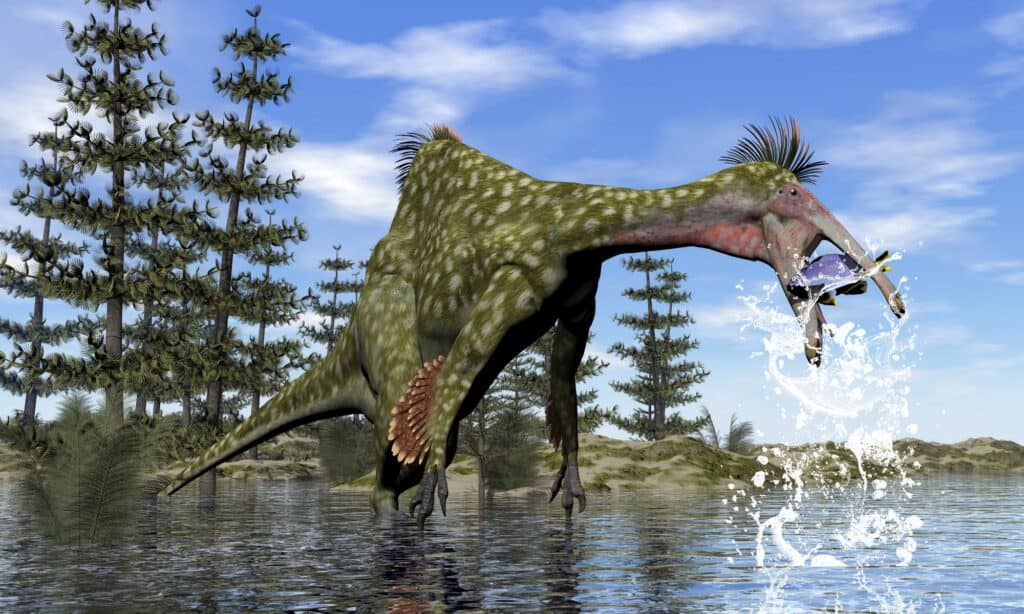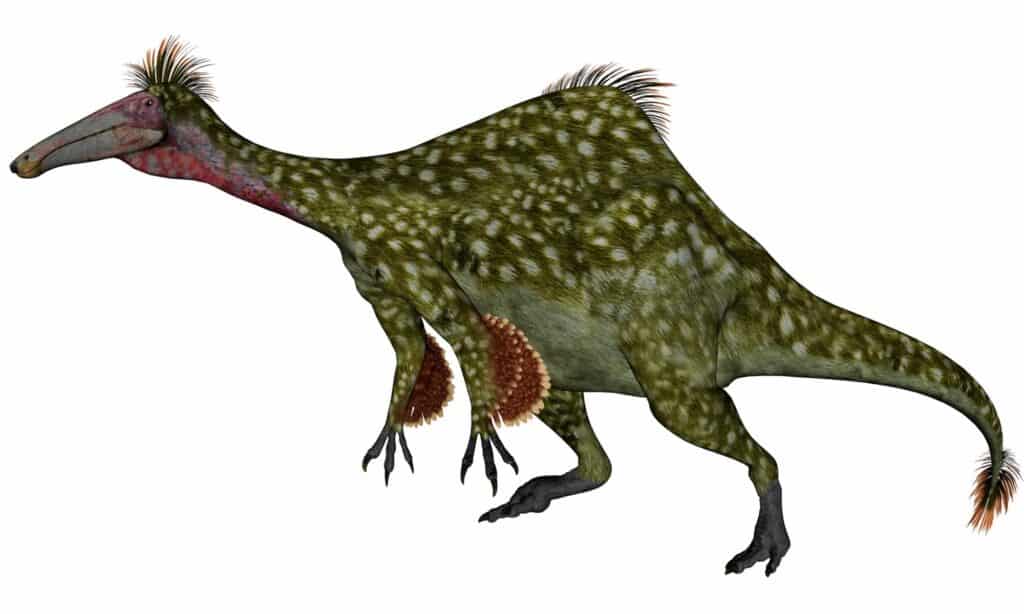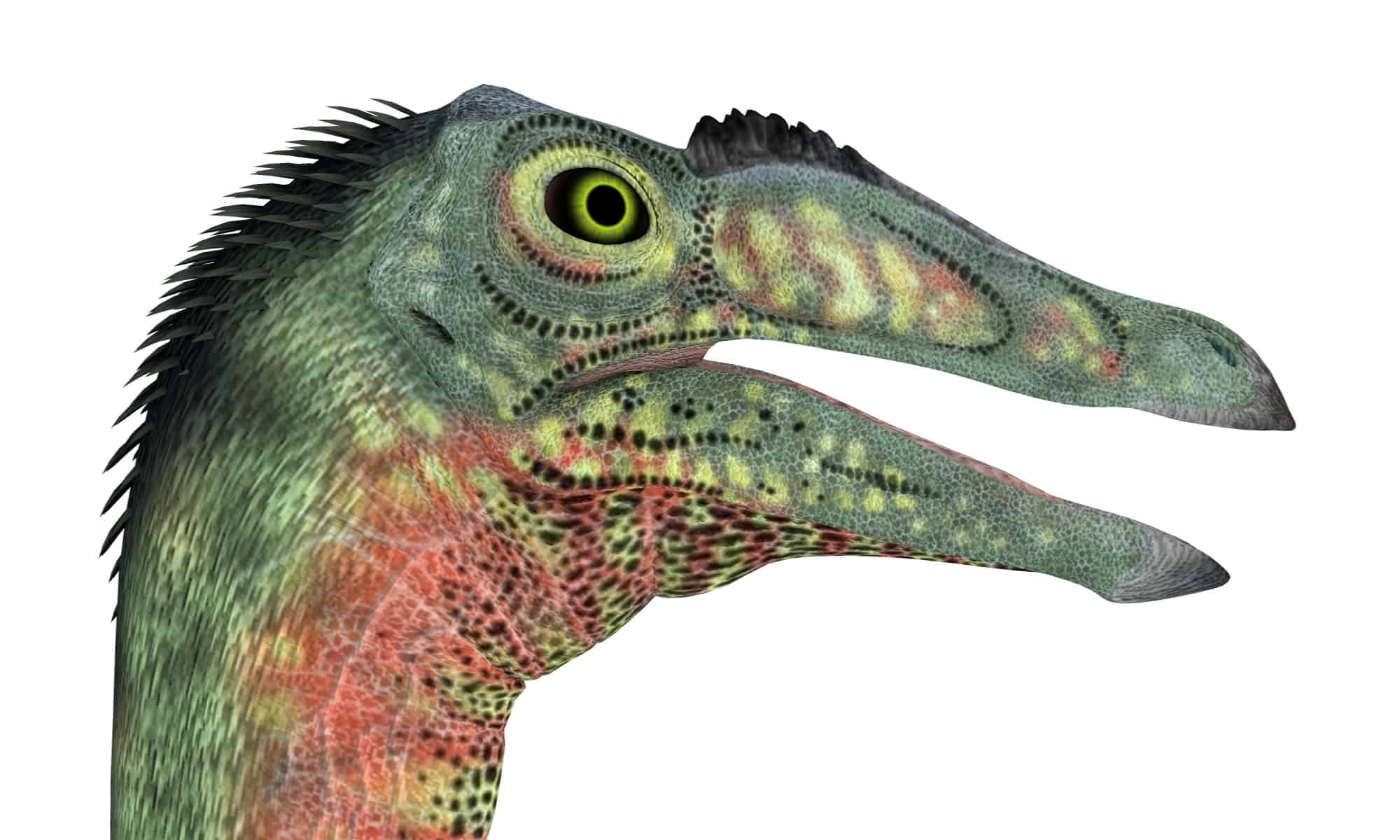Dinosaurs are a class of reptiles that dominated the earth for over 160 million years. They possessed various shapes and sizes and were able to survive various ecosystems. Dinosaurs were also diverse in body size, from the frightening giant Spinosaurus to the bird-sized Microraptor.
The dinosaurs also had a streamlined body with straight hind legs that enabled them to utilize less energy for locomotion than other reptiles that have to use their whole body. This contributed to their success. The dinosaur’s weight is supported by their unbent legs directly under their bodies
Other features that contributed to the success of dinosaurs were the presence of wings, claws, strong jaws, and diversified dentition. Their diversified dentition allowed them a wide range of diets.
Among these unique reptiles is the Deinocheirus, a class of 36ft tall reptiles with fearsome and gigantic claws. This class is our focus in this article.
Description And Size
Deinocheirus is a genus of the giant Ornithomimosaur dinosaurs that lived about 70 million years ago.
Deinocheirus is coined from two Greek words; deinos (δεινός), meaning “horrible,” and cheir (χείρ), meaning “hand,” due to the size and strong claws of the forelimbs. The specific name “mirificus” is derived from Latin and means “unusual” or “peculiar” due to the peculiar structure of the forelimbs.
Deinocheirus is a unique member of the order Ornithomimosauria; the most gigantic reptiles in this order were about 36ft long and weighed about 6.4 tons. Even though these animals were huge, they possessed many hollow bones, which reduced their weight.
The skull of this gigantic reptile was about 1.024 m (3.36 ft) long, with a broad bill and a deep lower jaw. This is in correlation with the animal’s mode of feeding.
The vertebrae (backbone) of Deinocheirus had elongated neural spines that constructed a sail along its back. Like any other bone in their body, the vertebrae of Deinocheirus were also pneumatized ( had holes) and housed air sacs.
In terms of its appendages, the arms of Deinocheirus were about 2.4m (7.9ft) long, one of the largest arms any bipedal dinosaur could have. The arms were equipped with three large fingers with large and blunt claws. Deinocheirus possessed relatively short legs, which also bore blunt claws.
This fearsome reptile had pygostyle-like vertebrae; this implies they had a tail that ended in a fan of feathers. Members of this genus were. Considering all the heavy features Deinocheirus had, this animal was not adapted for speed.
What Did Deinocheirus Eat?
Deinocheirus is believed to have been an omnivorous animal; it fed on both plants and animals. The shape of its skull shows that it feeds on plants. Additionally, some specimens of Deinocheirus had gastroliths in their abdominal region, while some were attributed to fish scales.
Moreover, their vast claws suggest that they used to dig and gather plants. Judging by their ecosystem, Deinocheirus would have eaten small animals like fish. Also, it may have competed for trees with other giant herbivorous dinosaurs, such as the long-necked theropod Therizinosaurus.

©iStock.com/Elenarts108
When And Where did Deinocheirus Live?
Deinocheirus is thought to have lived about 70 million years ago during the Late Cretaceous. Deinocheirus dinosaur fossils were discovered in 1965. Based on the discovery, it was agreed that the species must have resided in the present-day Mongolia Gobi desert. The fossils were preserved in a 70-million-year-old sandstone.
Paleontologists recovered specimens from the Nemegt Formation in the Gobi Desert of southern Mongolia. This made them believe that the Deinocheirus dinosaur must have stayed in a terrestrial habitat in the Central Asian Woodlands.
Based on the ongoing research about this class of dinosaurs, ancient water bodies were present in this region. The rock faces of the Nemegt Formation indicate the presence of stream and river channels, mudflats, and shallow lakes.
Hence, they probably lived upon jungly floodplains, thickly vegetated swamps, wooded areas, and seasides. A present-day environment that shares similar characteristics with the environment of Deinocheirus is the Okavango Delta of present-day Botswana.
Predators and Threat
Deinocheirus was likely to have been preyed on by Tyrannosaurus. Tyrannosaurus is another class of giant dinosaurs that were frightening and violent. Tyrannosaurus had a destructive bite and the speed to chase down prey (or enemies), unlike Deinocheirus.
The Tyrannosaur would have to be in a pack of two or three and focused on aged, sick, or young Deinocheirus that put up less resistance.
Environmental hazards during the late cretaceous period could have also affected Deinocheirus negatively. There were active volcanoes during this period, which made the climate warmer. Seafloor spreading often occurred during this period.
Also, the caliche deposits found indicate these animals experienced periodic droughts.
Where Were Deinocheirus Fossils Found?
In the 1960s, paleontologists from Poland and Mongolia embarked on several joint paleontological expeditions to the Gobi desert. Each expedition led to the discovery of dinosaurs and mammals from the Late Cretaceous period. In 1965, a group of paleontologists discovered Deinocheirus fossils in Mongolia.
The Polish-Mongolian team discovered a pair of giant arms that most likely belonged to a bipedal dinosaur. The arms were about the length of an ostrich and were named Deinocheirus mirificius, which implies “Marvelous terrible hands.” Its sight made Deinocheirus seem like a horrifying monster.
Early discoveries of Deinocheirus gave the notion that it was a long-armed carnivore, similar to Tyrannosaurus. However, further research opines that Deinocheirus was an ostrich-like dinosaur judging by the proportion of bones in that hand. Hence it was an Ornithomimosaur. Nevertheless, Deinocheirus dinosaurs remained an enigma for decades.
Today, fossils of Deinocheirus, along with other dinosaurs, are preserved in the Central Museum of Dinosaurs of Mongolia, a paleontological museum in Chingeltei District, Ulaanbaatar. This museum is dedicated to the preservation and discovery of dinosaur fossils.
When Did Deinocheirus Go Extinct?
Several forms of geographical evidence connote that an asteroid of about 10 kilometers in diameter hit the earth at the end of the Cretaceous Period. This asteroid is believed to have caused the extinction of most living things in that era, including the Deinocheirus dinosaurs.
What fortifies this evidence is an ancient impact crater situated in Mexico’s Yucatan Peninsula. This crater dates to the time of the extinction. Scientists believe the asteroid’s impact would have created a tremendous dust cloud that encircled the earth. The dust cloud must have significantly reduced the amount of sunlight getting to the Earth’s surface.
With little sun reaching the earth, plants died. The more miniature plant also meant less for herbivores, so the elimination process started from the herbivores to the carnivores and omnivores. Also, the impact of the asteroid, as well as the dust and debris falling to the Earth, must have triggered a widespread wildfire.

©iStock.com/Elenarts108
Similar Animals to Deinocheirus
Therizinosaurus
Therizinosaurus was a giant therizinosaurid that could grow up to 33 ft long and 16 ft tall. It was a slow-moving, long-necked, high browser with a horny beak and a broad torso for food processing. Its forelimbs were particularly large, with three fingers that bore unguals.
Spinosaurus
Spinosaurus remains the largest of all known terrestrial carnivores. Spinosaurid dinosaurs were about 41 to 59 ft in length and 7 to 20.9 metric tons in weight.
Spinosaurus had massive, robust forelimbs with three-fingered hands, with an enlarged claw on the first digit, and possessed straight conical teeth.
Tyrannosaurus
Tyrannosaurus retains its position among the largest known land predators and is believed to have exerted the strongest bite force among all terrestrial animals. It was a bipedal carnivore with a giant skull, large tail, and powerful hind limbs. Tyrannosaurus rex measures over 40.7 ft in length and about 14 metric tons (in weight.
Giganotosaurus
Giganotosaurus was one of the largest known terrestrial carnivores, with its teeth compressed sideways and with serrations. The neck was strong and the pectoral girdle proportionally. The complete specimen of Giganotosaurus ranges from a length of 12 to 13 m (39 to 43 ft) and a weight of 4.2 to 13.8 t (4.6 to 15.2 short tons).
Deinocheirus Facts
How to pronounce ‘Deinocheirus’
This Ornithomimosaur bipedal dinosaur, Deinocheirus, is pronounced ‘DINE-oh-KIRE-us.’
Paleontologists Discovered Two New Deinocheirus Specimens in 2013!
After about 50 years of discovering the first Deinocheirus fossil, paleontologists unearthed two new Deinocheirus specimens in Mongolia. One of the fossils had missing pieces, but with the help of poachers, the paleontologists were able to assemble the complete structure.
The Society of Vertebrates Paleontology announced the discovery at its 2013 meeting.
A Deinocheirus Specimen Contains Over 1,000 Gastroliths!
It’s not surprising for plant-eating dinosaurs to have deliberately ingested gastroliths. Gastroliths are small stones that help grind the tough plant matter in their stomachs.
One of the newly identified Deinocheirus specimens ingested over 1,000 gastroliths. This strongly supports that Deinocheirus was mostly a plant-eater.
Thank you for reading! Have some feedback for us? Contact the AZ Animals editorial team.








